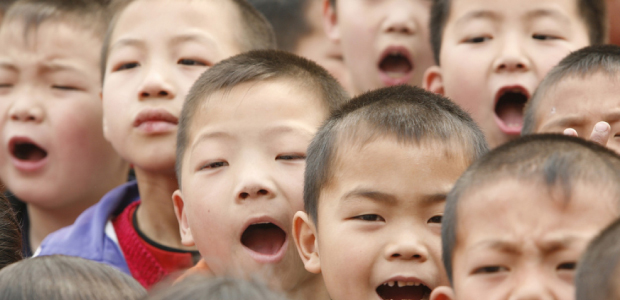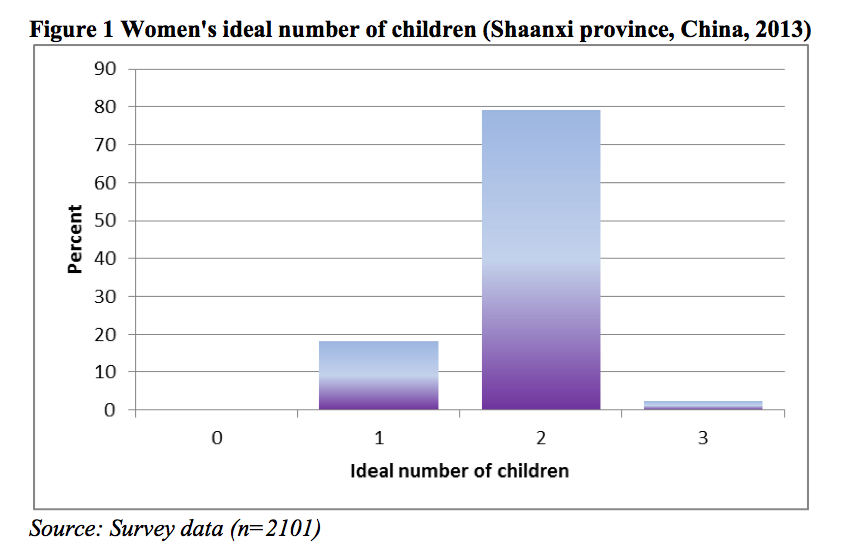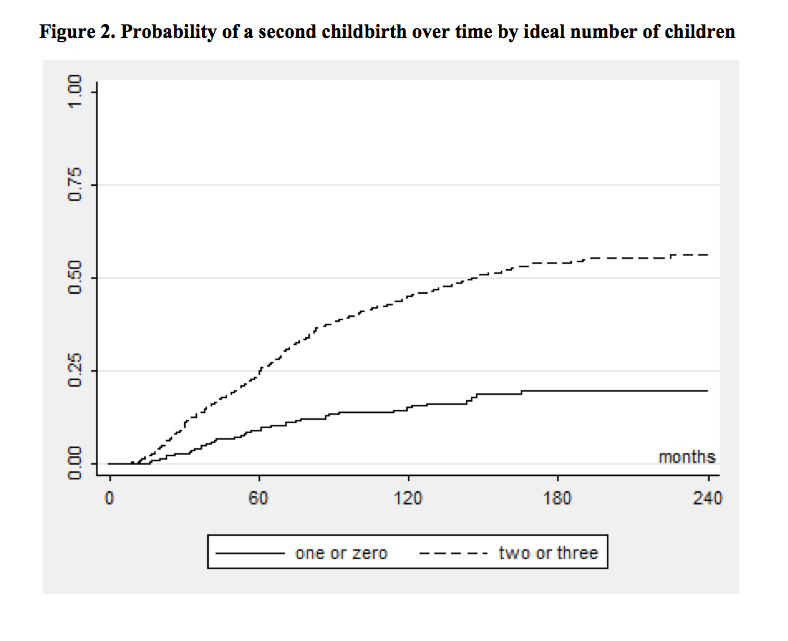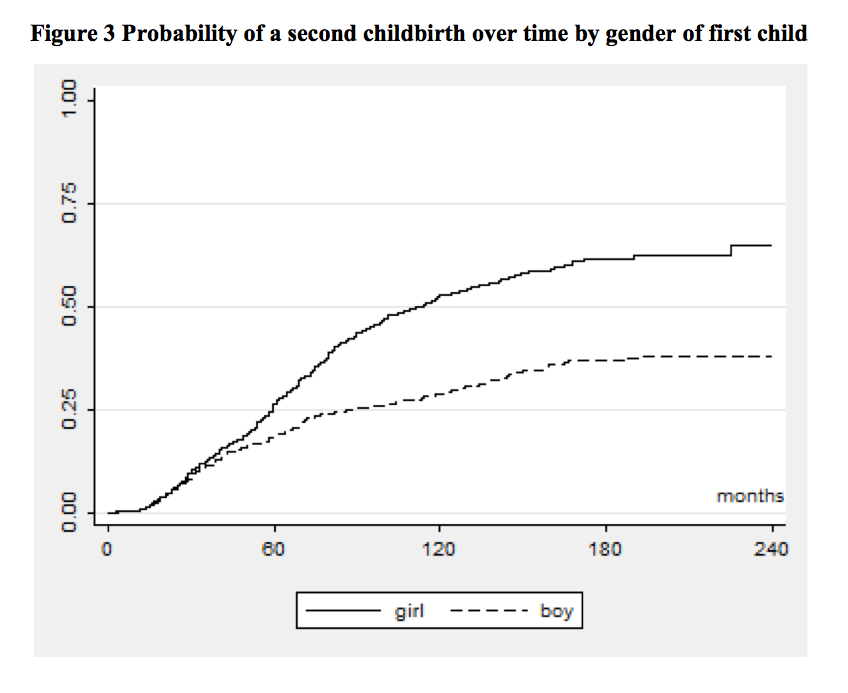China is now facing the challenge of low fertility. Its total fertility rate first fell below replacement level in the early 1990s, and had dropped to only 1.18 children per woman by 2010 (or, possibly, 1.5, taking account of possible underreporting; Cai, 2013).
Among the drivers of fertility decline, birth control policy is considered by some to be the most important, but this was probably true only at the beginning. In a context of socioeconomic transformation, low fertility in China today results mainly from low fertility intentions and preferences among its young people. The ideal number of children for most Chinese women is currently very low, between one and two.
Interwoven with this low fertility intention is deeply entrenched son preference. In the past, son preference was likely to raise fertility because parents would continue to give birth until the ideal gender composition or intended number of sons was reached (Guilmoto, 2012). However, with the development of fetal sex determination technology, which became widely available in China from the 1980s, couples are able to satisfy their son preferences via sex-selective abortions, which may lead to reduced fertility.
Fertility intention as a predictor of the second child
Fertility intentions have decreased continuously over recent decades in China. In a comprehensive meta-analysis of 227 surveys and 606,000 respondents since the early 1980s in China, a study reported that the ideal dropped from 2.13 children per women in the 1980s to 1.90 in the 1990s, and 1.67 in the 21st century (Hou et al., 2014). As shown in most other settings in the world, fertility outcomes fall below the ideal numbers, but the latter may be used to better understand the former, as in the case of the Chinese province of Shaanxi,¹ where a study carried out in 2013 shows an ideal fertility level of 1.84, only slightly above the national average.² The survey on which the study was based retrieved 2,920 valid questionnaires, from women aged 20 to 44 at the time of survey. Excluding 69 women who were divorced, separated, or widowed, 290 who were never married, and 460 who were married but had no children, analyses were restricted to 2,101 respondents.
The large majority (79.2 percent) of these 2,101 women reported an ideal number of children of two, with the remaining 18.2 percent reporting one (Figure 1). Figure 2 shows the cumulative probability of a second child by time elapsed since the first birth, separately for women with a “high” (2+ children) or “low” (0-1) ideal number of children. Five years (60 months) after the birth of the first child, the probability of having had a second birth was only 0.29 for women with high preferences, and only 0.10 for the others. After ten years, the two probabilities were 0.60 and 0.16 respectively. So, perhaps not surprisingly, fertility intentions predict, at least to some extent, the probability of having a second child in today’s China (Jiang et al., 2016).
Son preference and fertility (1)
Traditionally, Chinese families preferred to have at least one son to continue the family line and to provide care for the elderly. Before sex selection technologies were available and birth control was imposed, this cultural preference contributed to high fertility levels. However, with the growing popularity of fetal sex determination since the 1980s, people have been able to satisfy their son preferences via sex-selective abortions, which can depress fertility.
In Shaanxi province, urban couples (couples with urban household registration) were permitted only one child, whereas rural couples whose first child was a daughter were allowed to have another birth. In this context, it was much easier for couples with a daughter to have an extra child than it was for couples with a son, as indicated in Figure 3.
It seems that the greater probability of a second childbirth for couples whose first child is a daughter supports the claim that son preference increases the probability of an extra child and, in turn, raises fertility. However, this may be primarily due to the birth control policy which allowed couples with a daughter to have a second child.
Son preference and fertility (2)
We then examined the correlation of son preference with second childbirth probability. We measured son preference with the question: “If you were limited to one child, what would you want the child to be?” Possible answers were: “1. A boy, 2. A girl, 3. Doesn’t matter”. Those who preferred a boy were identified as having a son preference. After controlling for individual characteristics and socio-economic variables such as household registration type (which is an indicator of fertility policy) with Cox regression models, we found that women of childbearing age who reported son preference were much less likely to have had a second child than women without a son preference. After dividing the sample according to the gender of the first birth, we found that when the first child was a boy, the probability of a having had a second child was significantly lower for women with son preference.
The rationale of this result may lie in the fact that with a low ideal number of children, the parents who want to avoid a second birth while fulfilling their son preference will turn to sex identification technologies for the first birth and abort the fetus if it is a girl. If they have a son, they will be less likely to proceed to have a second child. This may also be indicated by the rise in the sex ratio at birth (the number of male births per 100 female births) for the first child, which increased in China from 107.1 in 2000 to 113.7 in 2010 (Jiang et al., 2016).
Is the recent easing of fertility constraints sufficient to reverse low fertility in China?
As fertility intentions are unlikely to recover in the near term, and with a son preference that is unlikely to disappear totally anytime soon, we predict that China’s fertility level will remain low, or very low. Therefore, it is essential for the Chinese government to remove all fertility constraints (Wang et al., 2013; Wang et al., 2016).
The Chinese governments has realized the negative implications of the (very) low fertility for long-term economic development, as well as for the age structure of the population. The rapid ageing problem, and the phenomenon of parents bereaved of their only child (in case of the child’s premature death) have drawn much attention to China’s low fertility level and fertility policy (Jiang et al., 2014). In 2013, the government initiated a partial fertility policy reform whereby if a spouse is an only child, the couple can have a second child. However, in the two years up to August 2015, just 1.69 million couples – a mere 15.4% of the 11 million who qualified for this policy change – actually requested permission for a second birth, well below the expectation.
In December 2015 the Chinese government adopted a universal two-child policy. The effect of this further relaxation remains to be seen, but according to some scholarly predictions and international experience, the Chinese government may soon realize that this is not enough. An immediate policy switch from an anti-natalist to a pro-natalist position might be a better approach for today’s China.
References
Cai, Y. 2013. China’s new demographic reality-learning from the 2010 census. Population and Development Review 39(3): 371–396.
Guilmoto, C. Z. 2012. Son preference, sex selection, and kinship in Vietnam. Population and Development Review 38(1): 31–54.
Hou, J., S. Huang, Z. Xin, L. Sun, H. Zhang, and D. Dou. 2014. The vicissitudes of Chinese fertility intentions: 1980–2011. Social Sciences in China 35(4): 78-97. (In Chinese).
Jiang, Q., Y. Li, and J. J. Sánchez-Barricarte. 2014. The risk of mothers losing an only child in China. Journal of Biosocial Science 46(4): 531-546.
Jiang, Q., Y. Li, and J. J. Sánchez-Barricarte. 2016. Fertility intention, son preference and second childbirth–Survey findings from Shaanxi Province of China. Social Indicators Research 125(3): 935-953.
Wang, F., Y. Cai, and B. Gu. 2013. Population, policy, and politics: How will history judge China’s one-child policy? Population and Development Review 38(s1): 115-129.
Wang, F., B. Gu, and Y. Cai. 2016. The end of China’s one-child policy. Studies in Family Planning 47(1): 83-86.
¹Shaanxi province is located in northwestern China. It is (very close to) average in several respects: e.g., economic development, fertility, fertility intentions, and birth control policy. This makes Shaanxi province a suitable site to examine the correlation between fertility intentions, son preference, and the birth of the second child.
² Fertility ideals should be measured before actual fertility is observed, to avoid ex-post rationalization. This proved impossible in this case: we must therefore rely on the (strong) assumption that family ideals have not changed over time – with respect to the actual number of children, at least.





